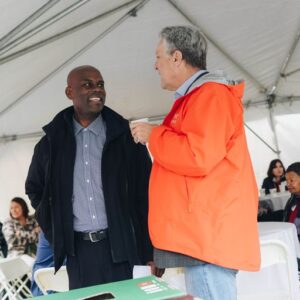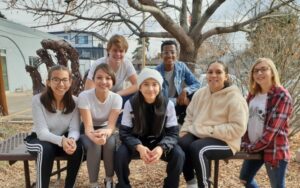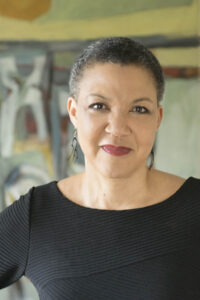Pictured above: community leaders participating in the Inclusiveness Project in 2001.
These are excerpts from Chapter 4 of our book, “A Century of Impact: The Denver Foundation’s First 100 Years.” It offers a glimpse into the history of the foundation, highlighting our ongoing journey to advance diversity, equity, and inclusion in our work. Read other excerpts from Chapter 4 here.
Looking Inward
In the mid-2000s, The Denver Foundation continued to support diverse organizations and communities but recognized that it could—and must—improve when it came to reflecting those communities within its own staff and leadership. The foundation had always prided itself on being a diverse place to work, from its days as a volunteer-run organization to its professional staff. However, the understanding of diversity and inclusion has evolved.
In 1992, the foundation boasted that its staff was diverse, which at the time meant it was balanced between male and female employees.

Today, our society sees diversity differently: it encompasses diversity of thought, race, gender and gender expression, sexual orientation, experience, religion, political stance, socioeconomic status, and more.
Beginning in 2001, the foundation made conscious efforts to create boards and committees that reflected Metro Denver more fully. The foundation invested in staff training and welcomed graduates of the Strengthening Neighborhoods Leadership Development Program to join grant-making committees and play an active role in supporting other up-and-coming community organizations.
The foundation’s open invitation was well received. Several graduates of the Leadership Development Program joined grant committees and, later, the board of trustees, including Jeff S. Fard, a longtime collaborator with The Denver Foundation and a graduate of the Leadership Development Program.
Turning Inclusiveness into Action

The Denver Foundation was inspired by the results of diversifying its own staff, committees, and board. What if all organizations had the opportunity to invest in up-and-coming leaders in their communities? The Inclusiveness Project began as a way to answer that question. The project sought to financially support community organizations as they trained and recruited more diverse staff—staff who reflected their communities but might not have the appropriate professional qualifications.
This groundbreaking capacity-building project helped community organizations train and hire local staff and recruit diverse board members. In 2011, the program received the Council on Foundations’ Critical Impact Award. Denver organizations—both grassroots and well-established nonprofits—joined the pursuit of becoming more equitable figures within their communities.
Lauren Casteel and the fostering of community service

Laureen Casteel spearheaded the Inclusiveness Project. Casteel served as the foundation’s vice president of philanthropic partnerships and donor services for 16 years. A familiar and influential name in the Denver nonprofit sector, she recently retired as the president of The Women’s Foundation of Colorado. As the daughter of civil rights leader Whitney Young, she was raised with the fight for justice and equity in her bones.
Casteel also oversaw the foundation’s Nonprofit Internship Program, which placed students in summer internships with organizations around Denver as a way to introduce promising young talent to the nonprofit field. This widely successful program generated enthusiasm, real-life experience, and plenty of heartwarming stories.
“One thing [the interns] learn from each other,” Casteel said, “is that while they come from extremely diverse backgrounds, and many come from extremely adverse situations, their profoundly human stories and common goal of service to the community bring them together, and in each case, the ambitions lead them to achieve—not solely for achievement’s sake, but for the sake of fostering reciprocity within Metro Denver communities.”
Tackling Systemic Issues
Today, The Denver Foundation balances buy-in from partners, community leaders, and everyday donors alike, ensuring that it is democratizing philanthropy. After decades of racial equity work led to new and formalized standards of inclusion, the “giving circles” movement was a natural evolution of that philanthropy.
In working to create equitable, sustainable policies within its organizational structure and grant programs, the foundation naturally wanted more input from the community. Giving circles are a way to bring donors of similar backgrounds together, in real time, to make decisions about how funds are given. Giving circle members are active players supporting the causes they choose through collective giving.
As the first giving circle at The Denver Foundation, and the first in the West for African-American men, Denver African American Philanthropists created an intentional space for Black philanthropists to direct how they distributed their funds to the communities they sought to support.
Beginning in 2012, members came together to hear each other’s thoughts and collaborate, and it gave them a larger platform by unifying their funds—donations large and small. The giving circle supports organizations such as the Urban League of Metropolitan Denver Inc., QueenShipp, Center for African American Health, and the Second Chance Center, all while creating community and fostering an “every dollar and opinion matters” mindset.
—Giving Circle member, 2022
Generosity and philanthropy have a legacy in communities of color that far predates The Denver Foundation, but the giving circle movement has amplified those already outspoken voices. The same is true for the philanthropists who make up the foundation’s other giving circles, including the Colorado Asian American Pacific Islander Circle, Latinos Impacting our Future Together (L.I.F.T.), and LatinasGive!. These communities have long been generous—since before The Denver Foundation existed— but the foundation can provide additional resources and an intentional space for collaboration.
Giving circle members give in ways beyond their individual financial support by sharing their time, talent, ties, and testimony as well. Many volunteer in their communities in addition to supporting charitable organizations. Recognizing the impact of this multi-layered work, the foundation created the Elevating Philanthropy in Communities of Color (EPIC) initiative to formalize its support of philanthropists, whether new or experienced. Building on giving circle members’ existing knowledge and experience, EPIC seeks to increase the impact of everyday philanthropists of color in ways that are meaningful to them.
As part of its journey of listening, learning, and collaborating to train the lens of racial equity onto everything it does, the foundation has regularly taken stock of its progress using third-party evaluation and other metrics. The foundation’s desire to be self-critical and respond to feedback creates an environment where hard conversations are not only possible but welcomed. It ensures that the foundation is ready to continue the work of listening by bringing a chorus of voices and experiences to the table for the next century to come.
